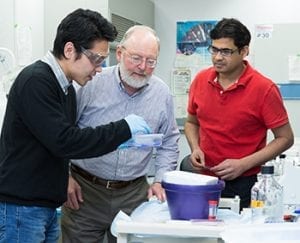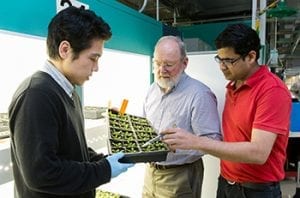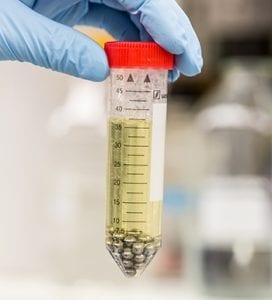News
Yet Another Impressive “Stunt” for Salicylic Acid

Klessig discusses new salicylic acid results with postdoctoral associates Hyong Woo Choi and Murli Manohar.
In humans, salicylic acid—administered in the form of aspirin—stops headaches, reduces fever and lowers the risk of heart attacks, strokes and certain cancers. But in plants, this hormone triggers a multitude of defensive tactics against bacteria, viruses and fungi.
New research from the laboratory of BTI Professor Daniel Klessig finds that salicylic acid, or SA, plays a role in resistance to tomato bushy stunt virus or TBSV by blocking viral replication. The study, which appears in the April 2015 issue of Molecular Plant-Microbe Interactions, reveals a novel role for SA in the plant immune system.

Choi shows the results of analysis by gel electrophoresis of several salicylic acid-binding proteins from model plant Arabidopsis and humans.
Researchers have long known that SA is vital to protecting plants from disease-causing microbes. It changes the expression of hundreds of defense-related genes and induces the production of reactive oxygen compounds, which help defend against the attacking pathogens.
“We’ve been interested in salicylic acid since our hallmark discovery in 1990 that SA is a major hormone in plants that regulates the immune response,” said Klessig. “Since then we’ve been attempting to discover its mechanisms of action using both genetic and biochemical approaches.”
Development of high-throughput screening methods in the Klessig laboratory over the past few years resulted in identification of almost two dozen proteins that bind SA, including glyceraldehyde 3-phosphate dehydrogenase or GAPDH. This important enzyme helps to break down glucose to provide energy. A search of the scientific literature revealed that some viruses, such as TBSV, use GAPDH to reproduce themselves inside plant cells.
TBSV is a virus that causes stunted growth, deformed fruits, and mottled leaves in tomatoes. The virus is a relatively short single strand of RNA wrapped inside a spherical coat of protein. Since this genomic RNA encodes only a few proteins, TBSV co-opts the plant’s cellular machinery to help copy itself.
To see if SA could combat the replication of TBSV through its interaction with GAPDH, Klessig teamed up with Peter Nagy, a professor of plant pathology at the University of Kentucky in Lexington, who had previously discovered that TBSV uses the plant GAPDH to replicate itself.
The researchers grew TBSV in several systems—whole yeast cells, cell-free extracts from yeast, and protoplasts, which are cells with their walls removed, from the model plant Nicotiana benthamiana—with and without SA. They found that SA inhibited TBSV from using the protein for its own replication in all three systems.
“SA binding to GAPDH prevented the protein from binding to the viral RNA,” said Klessig. “So not only were we able to show that it inhibited the replication of the virus, but also the mechanism of action.”
The findings suggest that farmers could protect plants from viruses that use GAPDH for replication by treating their crops with commercial preparations of chemicals that mimic salicylic acid.
Additionally, the results add to the growing list of roles that SA plays in protecting plants from infectious organisms.
“This was a significant finding because it has identified yet another mechanism of action of SA, which had not previously been known,” said Klessig.



